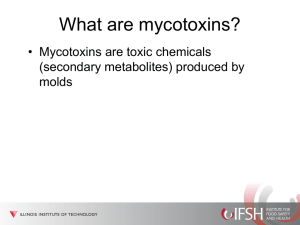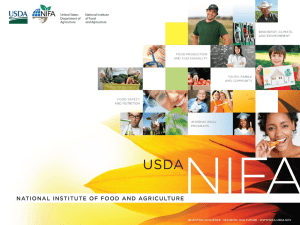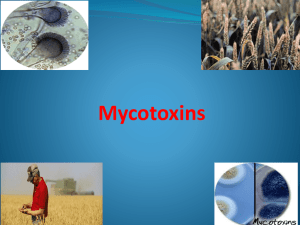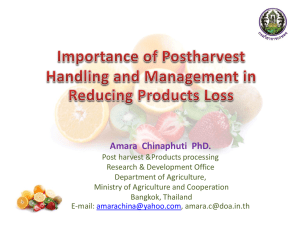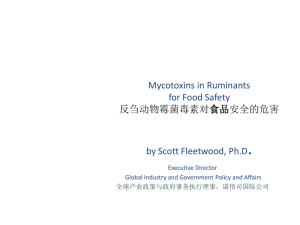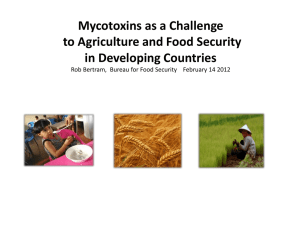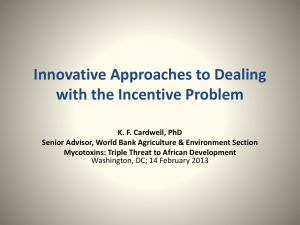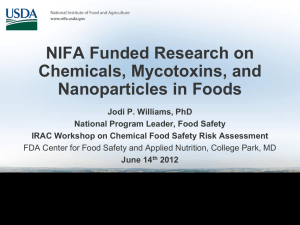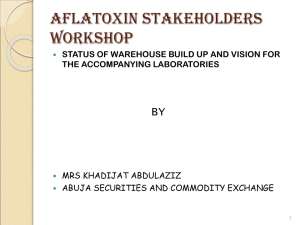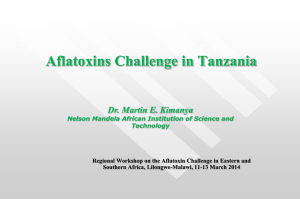MYCOTOXINS
advertisement
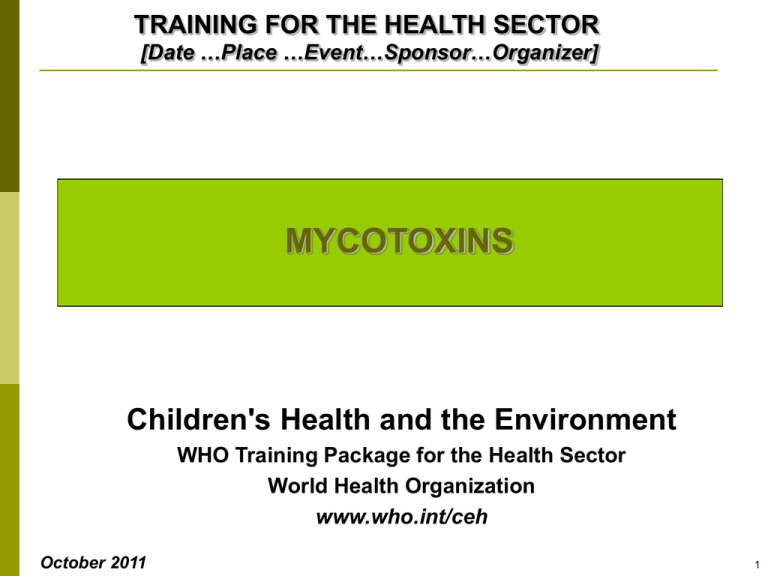
TRAINING FOR THE HEALTH SECTOR [Date …Place …Event…Sponsor…Organizer] MYCOTOXINS Children's Health and the Environment WHO Training Package for the Health Sector World Health Organization www.who.int/ceh October 2011 1 Mycotoxins LEARNING OBJECTIVES To understand that exposure to mycotoxins is associated with some diseases in children To describe routes of exposure to mycotoxins To consider some of the options for prevention of diseases associated with these toxins 2 Mycotoxins OUTLINE Case study Routes of exposure Toxin-related diseases Diagnosis and treatment The role of climate change Prevention, remediation, education Role of the health care provider 3 Mycotoxins CASE STUDY: SCHOOL OUTBREAK 155 of 452 elementary school children in USA became ill 15 minutes after eating school lunch Predominant symptoms: abdominal cramps in 88% vomiting in 62% headache in 62% nausea in 39% WHO 4 Mycotoxins CASE STUDY: HISTORY OF PRESENT ILLNESS Who else is ill? Many classmates When did symptoms begin? 12:30 pm today Where did symptoms start? In cafeteria 5 Mycotoxins CASE STUDY: SCHOOL OUTBREAK Illness linked to eating burritos for lunch What would you do next? ? ? ? 6 Mycotoxins CASE STUDY: DIFFERENTIAL DIAGNOSIS Because of the short incubation period, each of the following should be considered: Staphylococcus aureus (preformed toxins) Bacillus cereus (emetic toxin) Heavy metals (copper, tin, cadmium, iron, zinc) Natural toxins (vomitoxin =deoxynivalenol (DON) Mycotoxins CASE STUDY: SCHOOL OUTBREAK Burritos also implicated in 15 other outbreaks in 6 different states 2 million pounds of burritos recalled from two companies 8 Mycotoxins CASE STUDY: SCHOOL OUTBREAK 1700 primary schoolchildren in 6 states developed vomiting 15 minutes to 2 hours after eating lunch at the school cafeteria Lunch food (burritos) contained 0.3 ppm vomitoxin 9 Mycotoxins MOLDS AND MUSHROOMS Both are fungi Both include some poisonous varieties Example: Species of Amanita produce poisonous toxins Death may occur 4-7 days after ingestion Mortality rate 5-10% Halshka Graczyk 10 Mycotoxins MYCOTOXINS Myco: fungus Toxin: naturally-produced poison Natural products produced by fungi that evoke a toxic response when introduced in low concentrations to higher vertebrates by a natural route 350-400 known mycotoxins 11 Mycotoxins EVOLUTION OF MYCOTOXINS Probably a means of protection from insects, microorganisms, nematodes, grazing animals and humans “Chemical defense system” of the fungi or mold EPA 12 Mycotoxins CHEMICAL AGENTS PRODUCED BY MOLDS Mycotoxins are associated with human disease and cause acute and chronic effects Mycotoxins Aflatoxins Tricothecenes Ochratoxins and citrinin Hundreds of others Glucans (cell wall components) Volatile organic compounds (irritating) EPA 13 Mycotoxins ROUTES OF EXPOSURE Eating food or drink containing toxins Breathing moldy air in damp indoor areas Dermal absorption Mold growing on a wooden headboard in a room with high humidity EPA 14 Mycotoxins HOW CHILDREN ARE DIFFERENT Short stature Breathe closer to the ground Increased air intake Ongoing lung development WHO 15 Mycotoxins CONDITIONS LINKED TO MYCOTOXIN EXPOSURES Food poisoning and vomiting (vomitoxin) Aflatoxicosis (aflatoxin) Aplastic anemia (bone marrow failure) and bleeding (trichothecenes) Acute pulmonary hemorrhage Cancer (aflatoxins) Birth defects (fumonisins) 16 Mycotoxins AFLATOXICOSIS Acute high exposures (Africa, Asia): Vomiting Abdominal pain Hepatitis Death Lethal dose for adults: 10-20 mg Chronic low-dose exposures: Impaired growth 17 Mycotoxins ADVERSE HEALTH EFFECTS Deaths Hospitalizations Visits to Clinic Symptoms Annoyance, Discomfort WHO 18 Mycotoxins ANIMAL EXAMPLE: BLEEDING FROM TRICHOTHECENES Mycotoxicosis in horses first reported in 1931 (Ukraine) Massive numbers of horses died with gastrointestinal bleeding Horses ate hay heavily contaminated with Stachybotrys mold 19 Mycotoxins ANIMAL EXAMPLE: BLEEDING FROM TRICHOTHECHENES Alimentary Toxic Aleukia (ATA) First appeared in 1913 in far eastern Siberia Responsible for the death of at least 100,000 Russian people between 1942 and 1948 Necrotic ulcers in the mouth, throat, nose, stomach and intestines Bleeding from the nose, mouth, GI tract, and kidneys Associated with eating grains (wheat and corn) which had been under snow the previous winter Grains contaminated with Fusarium and Stachybotrys 20 Mycotoxins INFANT ACUTE PULMONARY HEMORRHAGE Emerging data show an association with indoor exposure to moldy home environments Mycotoxins on surface of spores may lead to capillary fragility Additional research ongoing Etzel 21 Mycotoxins CANCER Aflatoxin is a carcinogen (Group 1) Increases risk of hepatocellular cancer Fumonisins linked to oesophageal cancer International Agency for Research on Cancer Group B2 22 Mycotoxins BIRTH DEFECTS Fumonisins linked to neural tube defects Finding emerged from studies of women who consumed tortillas in Mexico WHO 23 Mycotoxins TOXICITY & BIOLOGICAL EFFECTS OF MYCOTOXINS IN FOODS Mycotoxin Major Foods Species Health effects LD50 (mg/kg) Aflatoxins Maize, groundnuts, figs, tree nuts (Aflatoxin M1 (secreted by cow after metabolism of aflatoxin B1), milk, milk products Aspergillus flavus Aspergillus parasiticus Hepatotoxic, carcinogenic 0.5 (dog) 9.0 (mouse) Cyclopiazonic acid Cheese, maize, groundnuts, Rodo millet Aspergillus flavus Penicillium aurantiogriseum Convulsions 36 (rat) Deoxynivalenol Cereals Fusarium graminearum Vomiting, food refusal 70 (mouse) T-2 toxin Cereals Fusarium sporotrichioides Alimentary toxic aleukia 4 (rat) Ergotamine Rye Claviceps purpurea Neurotoxin 24 Mycotoxins TOXICITY & BIOLOGICAL EFFECTS OF MYCOTOXINS IN FOODS Mycotoxin Major Foods Species Health effects LD50 (mg/kg) Fumonisin Maize Fusarium moniliforme Esophageal cancer ? Ochratoxin Maize, cereals, coffee beans Penicillium verrucosum Aspergillus ochraceus Nephrotoxic 20-30 (rat) Patulin Apple juice, damaged apples Penicillium expansum Edema, hemorrhage, possibly cancer 35 (mouse) Penitrem Walnuts Penicillum aurantiogriseum Tremors 1.05 (mouse) Sterigmatocystin Cereals, coffee beans, cheese Aspergillus versicolor Hepatotoxic, cancer 166 (rat) 25 Mycotoxins TOXICITY & BIOLOGICAL EFFECTS OF MYCOTOXINS IN FOODS Mycotoxin Major Foods Species Health Effects LD50 (mg/kg) Tenuazonic acid Tomato paste Alternaria tenuis Convulsions, hemorrhage 81 (female mouse) 186 (male mouse) Zearolenone Maize, barley, wheat Fusarium graminearum Oestrogenic Not acutely toxic 26 Mycotoxins OTHER CONDITIONS UNDER STUDY Sick Building Syndrome: Living in moldy indoor environments. Symptoms include: Fatigue Headache Difficulty in concentrating Many pure microbial toxins have been shown to be neurotoxic in vitro and in vivo such as the products of: Fusarium (fumonisin B1, deoxynivalenol) Stachybotrys (satratoxin G) Aspergillus (ochratoxin A) Penicillium (ochratoxin A, verrucosidin) 27 Mycotoxins CLIMATE CHANGE AND MYCOTOXINS Aflatoxins are expected to become more prevalent as climate continues to change Young children among most vulnerable WHO Enrique Montenegro 28 Mycotoxins CLIMATE CHANGE MANY INCREASE EXPOSURE TO MYCOTOXINS Extreme precipitation, storms and floods cause moist conditions that promote fungal growth Drought weakens seed kernels of plants, allowing greater fungal contamination Increased temperatures promote fungal growth WHO 29 Mycotoxins OTHER TOXICANTS OF BIOLOGICAL ORIGIN Toxicant Source Associated food Ciguatera dinoflagellates tropical fish Shellfish toxins: paralytic neurotoxic diarrhoeic amnesic dinoflagellates shellfish Pyrrolizidine alkaloids various toxic plants cereals, honey Histamine spoilage bacteria fish, cheese Mycotoxins EXAMPLE OF OTHER TOXINS: INCREASE IN SHELLFISH POISONINGS Heat-resistant toxins produced by algae Sudden increase ("bloom") in an area Four distinct syndromes: Paralytic (saxitoxin, gonyautoxin) Diarrhetic (okadaic acid, inophysistoxin) Neurotoxic (brevetoxins) Amnesic (domoic acid) Paralytic poisoning has high mortality rate 31 Mycotoxins ALGAL INTOXICATIONS ASSOCIATED WITH SHELLFISH Syndrome Symptoms Toxin Algal Species Amnesic shellfish poisoning Choking, vomiting, diarrhoea, incapacitating headaches, seizures, short-term memory loss Domoic acid Pseudonitzschia pungens Diarrheic shellfish poisoning Diarrhoea, vomiting, abdominal pain, nausea (may persist for several days) Okadaic acid Dynophysis acuta Dynophysis acuminata Dynophysis fortii Neurotoxic shellfish poisoning Paresthesia, reversal of hot and cold temperature sensitivity, myalgia and vertigo (generally mild) brevetoxins Ptychodiscus brevis Paralytic shellfish poisoning Tingling, numbness in fingertips and lips, giddiness, staggering, incoherent speech, respiratory paralysis Saxitoxin gonyautoxin Alexandrium (Gonyaulux) catenella Alexandrium tamarensis 32 Mycotoxins INTERVENTIONS To reduce airborne exposures to molds: Keep indoor areas dry Fix all leaks and clean up flooding within 24 hours Do not smoke indoors To reduce foodborne exposure to aflatoxin: Protect agricultural crops from moisture during both growth and post-harvest storage Do not eat grains with visible mold Computer models to predict mycotoxin levels 33 Mycotoxins INTERVENTIONS AFTER FLOODS Tetanus booster Food & water safety Sanitation & hygiene Power outages Carbon monoxide Animal & insects Cleanup Mold and mycotoxins Electrical hazards Reentering flooded buildings Centers for Disease Control and Prevention 34 Mycotoxins PREVENTION, REMEDIATION & EDUCATION Protect child and pregnant woman from ingesting or inhaling mycotoxins Protect agricultural crops Foods (especially grains) Water-damaged, moldy homes Folic acid supplements for women Growth Post-harvest Education Community leaders Consumer knowledge WHO 35 Mycotoxins HEALTH BENEFITS OF MYCOTOXIN REDUCTION Aflatoxin Reduction Cancer Trichothecenes Reduction ++ Respiratory Diseases + + Birth defects + + Mental Health Gastrointestinal Diseases Fusarium Reduction + +++ +++ +++ very good evidence, ++ good evidence, + some evidence 36 Mycotoxins CHILD'S AND ADOLESCENT'S COMPLEX SETTINGS ENVIRONMENTS HAZARDS Biological MEDIA Air - Food ACTIVITIES Eating, Breathing Rural/Urban Home School Field Street Workplace OUTCOME EFFECTS SUSCEPTIBILITIES Gastrointestinal disease Lung Disease Multi-system illnesses Death or Survival Critical windows/timing Age Nutritional status Poverty WHO 37 Mycotoxins CRITICAL ROLE OF HEALTH PROFESSIONALS Do research and publish results Detect sentinel cases Inspire community-based interventions Take history of childhood exposures Diagnose and treat Educate Patients and families Colleagues and students Advocate Provide good role model WHO 38 Mycotoxins HISTORY TAKING: POSSIBLE QUESTIONS Foods, home and habits Cultural history -Eating moldy grains? Cultural practices - Eating shellfish? - Do mother or father smoke tobacco? -Is the home water damaged or moldy? Parental work -What is the occupation of mother and father? - Any work with agriculture? Does family grow and store their own grain? 39 Mycotoxins POINTS FOR DISCUSSION 40 Mycotoxins ACKNOWLEDGEMENTS WHO is grateful to the US EPA Office of Children’s Health Protection for financial support that made this project possible and for some of the data, graphics and text used in preparing these materials for a broad audience. Further support was kindly provided by the UK Department of Health. First draft prepared by Ruth A. Etzel, MD PhD (WHO) With the advice of the Working Group Members on the Training Package for the Health Sector: Cristina Alonzo MD (Uruguay); Yona Amitai MD MPH (Israel); Stephan Boese-O’Reilly MD MPH (Germany); Stephania Borgo MD (ISDE, Italy); Irena Buka MD (Canada); Ernesto Burgio (ISDE, Italy); Lilian Corra MD (Argentina); Ligia Fruchtengarten MD (Brazil); Amalia Laborde MD (Uruguay); Jenny Pronczuk MD (WHO) Christian Schweizer TO (WHO/EURO); Kathy Shea MD (USA). Reviewers: Dr Huw Brunt (UK), Prof Gary Coleman (UK), Dr Raquel Duarte-Davidson (UK), Dr Elaine Lynch Farmery (UK), Alison M Good BSc Dip Med Tox MSc (UK), Dr Mark Griffiths (UK), Dr John Thompson (UK), Dr Laura Yates (UK) WHO Project coordination: Ruth A. Etzel, MD PhD Marie-Noël Bruné, MSc Latest update: October 2011 (H. Graczyk, L. Tempesta) 41 Mycotoxins DISCLAIMER The designations employed and the presentation of the material in this publication do not imply the expression of any opinion whatsoever on the part of the World Health Organization concerning the legal status of any country, territory, city or area or of its authorities, or concerning the delimitation of its frontiers or boundaries. Dotted lines on maps represent approximate border lines for which there may not yet be full agreement. The mention of specific companies or of certain manufacturers’ products does not imply that they are endorsed or recommended by the World Health Organization in preference to others of a similar nature that are not mentioned. Errors and omissions excepted, the names of proprietary products are distinguished by initial capital letters. The opinions and conclusions expressed do not necessarily represent the official position of the World Health Organization. This publication is being distributed without warranty of any kind, either express or implied. In no event shall the World Health Organization be liable for damages, including any general, special, incidental, or consequential damages, arising out of the use of this publication The contents of this training module are based upon references available in the published literature as of its last update. Users are encouraged to search standard medical databases for updates in the science for issues of particular interest or sensitivity in their regions and areas of specific concern. If users of this training module should find it necessary to make any modifications (abridgement, addition or deletion) to the presentation, the adaptor shall be responsible for all modifications made. The World Health Organization disclaims all responsibility for adaptations made by others. All modifications shall be clearly distinguished from the original WHO material. 42
